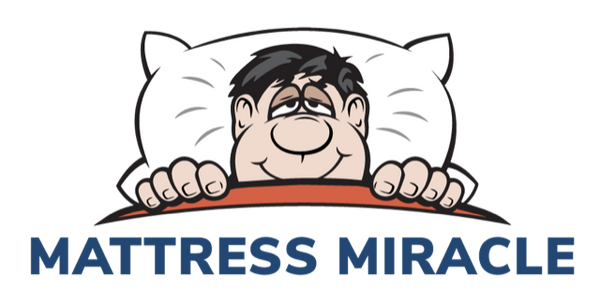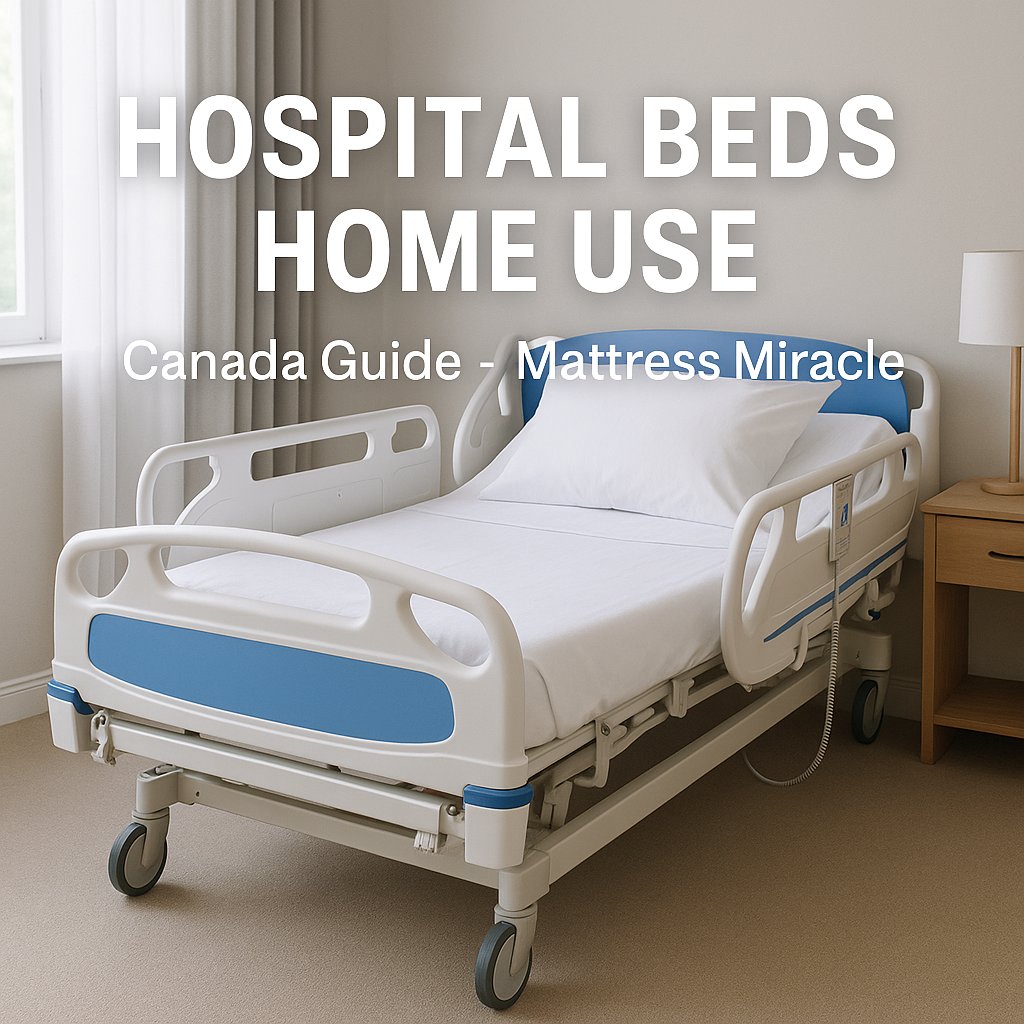Quick Answer
Hospital Beds for Home Use Canada - At Mattress Miracle Brantford, we provide expert sleep solutions with 37+ years of experience. Visit our showroom or call 519-770-0001.
Hospital Beds at Home - Let's Talk Real Solutions!
Hello, folks looking into hospital beds for home use! Dealing with medical needs at home? You've come to the right place. At Mattress Miracle in Brantford, we've been helping Canadian families navigate medical sleep solutions for over 37 years, and we're here to share our honest insights about bringing hospital-grade comfort into your home.
Let's dive into what actually matters when you're looking at hospital beds for your family.
Why We Care About Hospital Beds at Home
Here's something we've learned after decades in the business: when someone needs a hospital bed at home, it's usually a pretty serious situation. Maybe it's recovery from surgery, dealing with a chronic condition, or caring for an aging parent - and honestly, it can feel overwhelming.
What makes hospital beds different from our regular adjustable beds? Well, hospital beds are built for safety first, medical function second, and comfort third. Regular adjustable beds? They're all about comfort and convenience. Both have their place, and we can help you figure out which makes sense for your situation. For the full picture on all your options, check out our complete adjustable beds guide.
Talia's Modern Sleep Science Take
"The research really backs this up - proper bed positioning can reduce hospital readmissions by up to 23% for surgery recovery and chronic conditions. It's not just about comfort, it's about creating the right healing environment at home. When families can manage positioning properly, we see better recovery outcomes." Want to understand all the medical benefits? Our medical benefits guide covers everything.
Types of Hospital Beds for Home Use
Manual Hospital Beds
Hand-crank operated beds offering basic head and foot elevation. These budget-friendly options require caregiver assistance but provide essential positioning without electrical requirements.
Semi-Electric Hospital Beds
Combining electric head and foot adjustment with manual height control. These beds offer patient independence for positioning while maintaining cost-effectiveness.
Full Electric Hospital Beds
Complete electric operation including bed height adjustment. These premium options provide maximum independence and caregiver convenience for all positioning needs.
Low Hospital Beds
Specialty beds that lower closer to the floor, reducing fall risk for patients with dementia or mobility issues. Essential for high-risk patient populations.
Dorothy's Customer Care Insights
"I've helped hundreds of families through this decision, and here's what I've noticed: if someone needs frequent position changes or the caregiver isn't always available, electric is the way to go. Manual beds work fine for stable situations where positioning doesn't change much. Every family is different, but safety and independence level should guide your choice."
Essential Medical Features
Safety Features
- Side rails: Full, half, or quarter rails for fall prevention
- Emergency brake release: Quick-release mechanisms for emergencies
- Central locking wheels: Secure bed positioning during transfers
- Obstruction detection: Automatic stop for safety during adjustment
- Battery backup: Emergency power for essential functions
Positioning Capabilities
- Trendelenburg positioning: Feet higher than head for circulation
- Reverse Trendelenburg: Head higher than feet for respiratory support
- Fowler positions: Various head elevations (15-90 degrees)
- Cardiac chair position: Optimal positioning for heart conditions
Accessibility Features
- Height adjustment (typically 12-30 inches)
- Easy-entry/exit positioning
- Caregiver access from all sides
- Medical equipment compatibility
Medical Conditions Benefiting from Hospital Beds
Mobility and Orthopedic Conditions
- Hip or knee replacement recovery
- Spinal surgery rehabilitation
- Arthritis and joint pain management
- Fracture healing and immobilization
Respiratory Conditions
- Sleep apnea management
- Chronic obstructive pulmonary disease (COPD)
- Pneumonia recovery
- Congestive heart failure
Neurological Conditions
- Stroke recovery and rehabilitation
- Parkinson's disease management
- Multiple sclerosis support
- Dementia and Alzheimer's care
Matt's Technical Analysis
"From a medical standpoint, hospital beds reduce pressure ulcer development by up to 60% compared to standard beds. What most people don't realize is that it's not just the bed - it's the ability to make those regular position changes that makes the difference. The pressure redistribution features actually work."
Provincial Health Coverage in Canada
Provincial Differences
Hospital bed coverage varies significantly across Canadian provinces:
Ontario
- OHIP covers medically necessary hospital beds
- Requires physician prescription and assessment
- Coverage through Assistive Devices Program (ADP)
- 75% coverage with approved suppliers
British Columbia
- Medical Services Plan coverage available
- British Columbia Assessment Centre evaluation required
- Loan program for temporary needs
- Purchase subsidies for permanent requirements
Alberta
- Alberta Aids to Daily Living program
- Coverage for basic manual and semi-electric beds
- Client copayment required
- Assessment through occupational therapy
Quebec
- Régie de l'assurance maladie du Québec coverage
- Prescription from treating physician required
- Rental options for short-term needs
- Purchase programs for long-term use
Brad's Owner Perspective
"After 37 years in this business, I've learned that the coverage application process can be frustrating. Start with your family doctor for the medical assessment - don't skip this step. Contact your provincial program early because approvals take 4-8 weeks minimum. We've seen families wait longer because they didn't have all their documentation together. That's why we help walk families through this process."
Medical Documentation Requirements
Physician Assessment
Healthcare providers must document:
- Primary medical condition requiring bed
- Specific positioning needs
- Safety concerns with standard beds
- Expected duration of need
- Alternative treatment considerations
Functional Assessment
- Mobility limitations and transfer abilities
- Cognitive status and safety awareness
- Caregiver availability and capabilities
- Home environment suitability
Occupational Therapy Evaluation
- Activities of daily living assessment
- Environmental barrier identification
- Equipment recommendations
- Training requirements for patient and caregivers
Home Installation Considerations
Space Requirements
- Bed clearance: Minimum 3 feet on transfer side, 2 feet on other sides
- Ceiling height: Account for bed height adjustment and patient transfers
- Doorway width: Standard hospital beds require 32-36 inch clearance
- Floor support: Ensure adequate weight capacity for bed and patient
Electrical Requirements
- Dedicated electrical outlet within 6 feet
- Ground fault circuit interrupter (GFCI) protection recommended
- Emergency lighting considerations
- Power backup planning for critical patients
Accessibility Modifications
- Ramp installation for delivery
- Door widening if necessary
- Bathroom proximity and accessibility
- Emergency access planning
Real Customer Experience
"Brad and his team were absolutely amazing! My elderly dog was having trouble with stairs. We had to move down stairs and needed a hospital bed solution. The professional service and understanding of our unique situation made all the difference." - Sarah W., Brantford
Mattress Compatibility and Pressure Relief
Medical Mattress Types
- Pressure redistribution foam: Multi-layer designs for pressure point relief
- Low air loss mattresses: Active airflow for moisture and temperature control
- Alternating pressure systems: Cycling inflation for circulation enhancement
- Bariatric mattresses: Heavy-duty options for higher weight capacities
Pressure Ulcer Prevention
- Regular position changes (every 2 hours minimum)
- Skin inspection protocols
- Moisture management systems
- Nutritional support for tissue health
Infection Control
- Antimicrobial mattress covers
- Easy-clean surfaces
- Fluid-resistant materials
- Regular sanitisation protocols
Caregiver Training and Support
Bed Operation Training
- Safe positioning procedures
- Emergency lowering protocols
- Side rail usage and safety
- Transfer techniques
Patient Care Protocols
- Pressure ulcer prevention routines
- Positioning schedules
- Skin assessment procedures
- Equipment maintenance tasks
Support Resources
- Home healthcare nursing services
- Equipment supplier training programs
- Community support groups
- Telehealth monitoring options
Rental vs. Purchase Decisions
Rental Advantages
- Lower initial cost for short-term needs
- Maintenance and service included
- Easy equipment exchanges if needs change
- No long-term commitment
Purchase Benefits
- Cost-effective for long-term use (over 6 months)
- Equipment customisation options
- No monthly payments
- Potential insurance coverage for purchase
Jeff's Delivery & Setup Insights
"After delivering thousands of medical beds across Southern Ontario, I've seen how cost considerations affect families. Rental runs $100-300 monthly, purchase is $1,500-5,000. From my experience, if you're looking at more than 6 months, purchase usually makes more sense financially. But every family's situation is different."
Frequently Asked Questions
How do I qualify for provincial coverage of a hospital bed?
Qualification requires medical documentation of need from your physician, functional assessment, and approval from your provincial assistive devices program. The process typically takes 4-8 weeks.
Can hospital beds be used long-term in homes?
Yes, hospital beds are designed for extended home use. Many families use them permanently for chronic conditions or ongoing care needs with appropriate medical supervision.
What maintenance do hospital beds require?
Regular cleaning, annual safety inspections, and periodic motor servicing. Most suppliers provide maintenance programs for both rental and purchased equipment.
Are hospital beds safe for elderly patients with dementia?
With proper safety features like low height settings, appropriate side rails, and floor padding, hospital beds can be safer than standard beds for dementia patients prone to falls.
How do hospital beds affect home insurance?
Most home insurance policies cover medical equipment, but notify your insurer about the hospital bed to ensure proper coverage for the equipment and any related modifications.
What Our Customers Are Saying
Don't just take our word for it - here's what some of our customers have shared about their medical bed experiences:
- "Brad and his team were absolutely amazing! They helped us navigate the whole process with such care and understanding." - Brandy B., Brantford
- "Dorothy was amazing teaching us about the different options. She really took the time to understand our specific medical needs." - Jaylene C., Local Family
- "These guys have the best service I've ever experienced! They go above and beyond for families dealing with medical situations." - Kaden G., Satisfied Customer
Come See Us in Brantford!
We invite you to visit our showroom to see these medical solutions for yourself. There's really no substitute for understanding your options in person. Our team - Brad, Dorothy, Talia, Matt, and Jeff - each bring different perspectives to help you find the perfect medical bed solution.
Mattress Miracle
441 1/2 West Street, Brantford, ON N3R 3V9
Phone: (519) 770-0001
Hours: Monday-Wednesday 10am-6pm, Thursday-Friday 10am-7pm, Saturday 10am-5pm, Sunday 12pm-4pm
Remember, choosing the right hospital bed is one of the most important decisions you can make for medical care at home. Whether you go with manual, semi-electric, or full electric, we're here to make sure you get the right medical solution.
Thanks for considering Mattress Miracle for your medical bed needs - we look forward to helping you find the perfect home healthcare solution!
Professional Delivery & Setup Service | Provincial Coverage Assistance | Medical Equipment Expertise | Serving Canadian families since 1987

